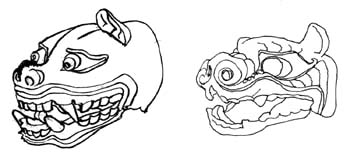|
||
 |
||

(C)2001 Japanese Architecture and Art Net Users System. No reproduction or republication without written permission.
掲載のテキスト・写真・イラストなど、全てのコンテンツの無断複製・転載を禁じます。
|
||||||
| Shishi 師子 | ||||||
| KEY WORD : art history / sculptures | ||||||
| Chinese Temple Lion. Refers to the role and the mask representing a temple lion shishi 獅子. The oldest variety are gigaku shishi masks *gigakumen 伎楽面 dating from the 7-12c. Gyoudou sishi masks gyoudoumen 行道面 date back to the 12c and can be found throughout the country. Similar shishi masks and performances continued to be popular through the Edo period until the present day. Shishi is also the name of a noh mask *noumen 能面 representing a dancing lion worn in the 15c *nou 能 play *SHAKKYOU 石橋 (see *shishiguchi 獅子口). Movable jaws and ears, flaring nostrils and bulging eyes characterise the gigaku and gyoudou lion masks. A large cloth attached around the back of the mask to drape over one or two people often serves as the body of the lion. The gigaku shishi was manipulated by two people, one for the front feet and head, the other for the body and back feet. An illustration in the Shinzei kogaku-zu 信西古楽図 (Shinzei's Illustrations of Ancient Music; 12c, Youmei Bunko 陽明文庫, Kyoto), depicts a furry lion led on a rope held by a man accompanied by two boys wearing the masks of *Shishiko 師子児. They are followed by musicians who presumably beat out lively rhythms for the shishi dance. For the gyoudou 行道 performance, one performer manipulates the mouth and swings the head back and forth in an undulating movement while taking high steps. Another performer bends over to form the back of the lion and its hindlegs. Seen frequently in Japanese festivals depicted in Edo period genre screens and handscrolls and even today especially during the summer, the dance and mask bear similarities to certain dances in China, South-East Asia and Indonesia. Unlike other shishi masks, the nou shishi mask is worn on the face by a single performer. The noh mask is characterized by flaring open jaws and large, bulging gold eyes, and curling tongue. Vermillion is used to accent the gold. The father lion, oojishi 大師子, appears near the stone bridge with his two cubs, kojishi 小師子, and dances among the peonies. The model mask for the nou shishi is attributed to Shakuzuru 赤鶴. Compare: somakusha 蘇莫者. See *bugakumen 舞楽面. | ||||||
 |
||||||
| REFERENCES: | ||||||
| EXTERNAL LINKS: | ||||||
| NOTES: | ||||||
(C)2001 Japanese Architecture and Art Net Users System. No reproduction or republication without written permission. 掲載のテキスト・写真・イラストなど、全てのコンテンツの無断複製・転載を禁じます。 |
||||||